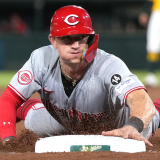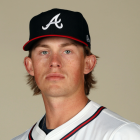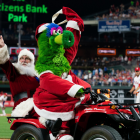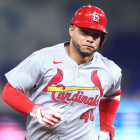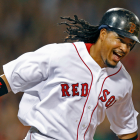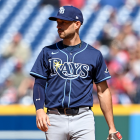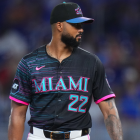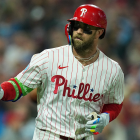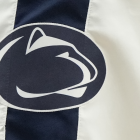Prospect Watch: Checking in on 2023 draftees for each National League team ahead of 2024 MLB draft
How have last year's top picks taken to pro ball?

Major League Baseball's amateur draft is only a matter of weeks away. The first round will get underway on Sunday, July 14, coinciding with the start of the All-Star Game festivities. But, before we turn our attention to this year's draftees, we wanted to take a moment to look back at last year's class.
For those new to the Prospect Watch feature, we typically run it on the first two Fridays of each month (we're a few days early this time). One piece focuses on the National League, the other on the American League. We almost always have a single theme. Take this edition of Prospect Watch, where we'll be checking in on how each NL club's top draft pick from last summer has fared thus far this season. (Do note that we'll do the same exercise next week for the American League crop.)
Simple enough, right? Now, let's get to the good stuff.
| INF Tommy Troy: Troy greatly improved his stock in his final year at Stanford, launching a career-best 17 home runs and leveraging his well-above-average wheels to steal 17 bases. His first full professional season hasn't gone as well: in 12 High-A games before suffering a strained hamstring, he batted .184/.231/.286 with seven more strikeouts (10) than walks. Troy has the means to become a starting-caliber player at the game's highest level, so we'd advise being patient. | |
| RHP Hurston Waldrep: Waldrep was one of our favorite pitchers in last year's class thanks to a stellar fastball-splitter combination. His well-below-average command projection caused him to slip to the Braves at No. 24. Waldrep has spent this season at Double-A, averaging nearly a strikeout per inning while showing a greatly improved walk rate over his 5 per nine rate at Florida. If he keeps throwing a reasonable amount of strikes, he'll likely find his way to the majors this year. | |
| 3B Matt Shaw: Shaw, the 13th pick by way of Boston College, had one of the most impressive introductions to pro ball. In 38 games across three levels last year, he posted a 1.018 OPS and put himself into position where he could conceivably debut this summer. Shaw has scuffled as of late at Double-A, but there's no sense overreacting to a small sample. He projects as an above-average hitter who can get the job done at the hot corner. | |
| RHP Rhett Lowder: Lowder, the second pitcher drafted last summer, was expected to move quickly thanks to the polish he developed at Wake Forest. Sure enough, he reached Double-A in early May. Lowder has experienced some turbulence at the level, potentially delaying his further ascent to the majors. We expect that he'll get the ship righted in time to make his big-league debut later this year, with an eye on breaking camp next spring as part of Cincinnati's rotation. | |
| RHP Chase Dollander: Dollander was considered the best pitcher in the class entering last spring. His subsequent struggles with consistency caused him to slip to the Rockies at No. 9. He's spent this season at High-A, demonstrating that his stuff clearly works against professional hitters. Dollander has already recorded multiple double-digit strikeout games, punching out more than 40% of the batters he faced through his first six outings. Dollander's walk rate is on the bloated side, but otherwise, the Rockies have to be happy with his introduction to the organization. | |
| OF Kendall George: George, who received the lowest signing bonus of the 39 first- and supplemental-round picks, is a throwback player. He's blazing fast and walks nearly as often as he strikes out, but there's just one catch: he's bereft of power. George recorded one extra-base hit in his first 27 games, leaving him with an absurd .010 ISO. Whatever your mental reference for a fast, no-slug outfielder is -- Joey Gathright, Ben Revere, Jason Tyner -- just know that their big-league ISO was significantly higher than that. It's worth giving George some more time in the Dodgers player development system, but he's going to have to find more wallop to make this work. | |
| RHP Noble Meyer: The Marlins chose Meyer 10th overall last summer, despite the wretched history of first-round prep arms, based on the strength of his sturdy frame and promising arsenal. His first full professional season has been a mixed bag. He's already had three starts where he's walked four or more batters, including one in which he was yanked before completing an inning. Meyer was always going to be a long-term play -- you don't take a prep arm expecting them to move quickly -- so stay tuned. | |
| 3B Brock Wllken: Wilken suffered multiple facial fractures the first week of the season after being struck by a pitch. He returned in early May, but hasn't been able to get on track -- understandably, in our opinion, given the potential mental aftereffects that come with being hit in the face. Wilken has massive raw power and a history of hit-tool concerns stemming from his strikeout tendencies. | |
| SS Colin Houck: Houck is an athletic infielder with slugging upside who has had a miserable go of things in A-ball. He's averaging more than 1.5 strikeouts per game, fueled by an unfathomably high whiff rate on non-fastballs. | |
| SS Aidan Miller: Miller is one of the few first-round prep hitters holding his own in A-ball. He's shown a good feel for the strike zone, and for hammering fastballs. He's also already hit a ball harder than 108 mph, a figure that would put him in company with the likes of Kyle Tucker and Mookie Betts. Not bad for someone nearing their 20th birthday. The Phillies have continued to play Miller at shortstop but the expectation is that he'll end up at third base. That won't matter too much provided he keeps on hitting. | |
| RHP Paul Skenes: What is there to write? Skenes, the No. 1 overall pick, has already reached the majors and enjoyed a good deal of success thanks to an unmatched power arsenal that includes a 100 mph four-seamer, a new mid-90s sinker, and a swing-and-miss slider. So far, it looks the Pirates nailed it. | |
| OF Dillon Head: Head, a speedy outfielder with some offensive promise, didn't last a year with the Padres. He's already been shipped off to Miami as part of the trade that fetched Luis Arraez. | |
| 1B Bryce Eldridge: Eldridge was one of the most intriguing two-way players in last year's class. The Giants have already punted on having him pitch, instead asking him to focus on developing into a middle-of-the-order thumper. Eldridge has been one of the most productive hitters in the San Jose lineup despite also being the youngest. That's a promising sign. | |
| OF Chase Davis: Davis made marked improvements at Arizona to solidify himself as a first-round pick last summer. At the time, he looked like a potential middle-of-the-order bat thanks to his above-average power and eye. Unfortunately, you wouldn't know that based on how he's performed as a professional. Davis' struggles in the Florida State League have reached the point where it's getting worrisome. This is, put simply, not what we expected from someone who looked like one of the better second-tier college bats in last year's class. | |
| OF Dylan Crews: Crews was widely considered to be the best prospect in the draft. It's fair to write that he's since been leapfrogged by both Skenes and Wyatt Langford, who will be part of the American League column next week. Crews has spent this season in Double-A, where he's sporting a surprisingly ugly strikeout-to-walk ratio given his pedigree and his performance in the SEC. He has hit better as of late, and he's still a candidate to make his big-league debut later this season. | |




















